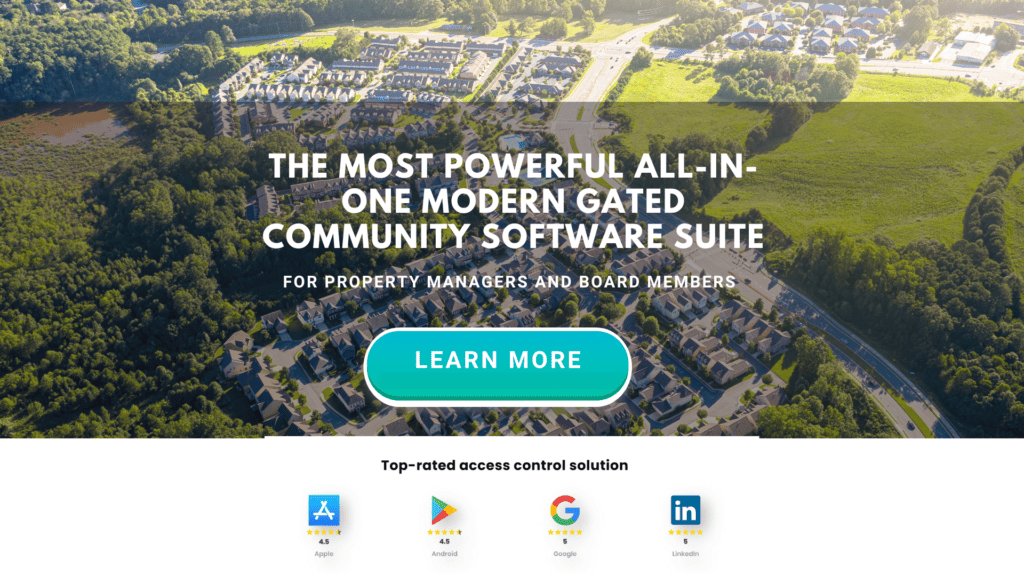Gated communities, multi-residence buildings, and private clubs constantly seek ways to improve security and convenience for residents and visitors. One prominent technology is License Plate Recognition (LPR) for gate access. By automating vehicle entry, LPR simplifies operations, enhances security, and creates a seamless experience for authorized users.
This article will explore how LPR systems work, their benefits for access management, and why they’re becoming an essential feature for modern gated properties.
IN THIS ARTICLE
- What is LPR for Gate Access?
- How LPR Systems Work
- Benefits of LPR for Gate Access
- Key Features to Look For in an LPR System
- Challenges and How to Overcome Them
- Why LPR is the Future of Gate Access
What Is LPR for Gate Access?
License Plate Recognition (LPR) is a technology that uses cameras and software to read vehicle license plates and automatically grant or deny access based on pre-configured permissions.
LPR systems replace traditional methods like manual verification, keypads, or RFID tags, offering a modern, efficient solution for controlling vehicle entry at gated access points.
In communities or properties with heavy traffic, LPR for gate access ensures that only authorized vehicles are allowed entry while maintaining a record of all vehicle activity for enhanced security.
How LPR Systems Work
LPR systems operate through a combination of hardware and software designed to capture and process vehicle license plates quickly and accurately. Here’s a step-by-step look at how it works:
How LPR for Gate Access Works: Step-By-Step
1. High-Definition Cameras
At the heart of any License Plate Recognition (LPR) system are the high-definition cameras installed at gate entrances. These cameras are specially designed to:
- Capture Clear Images: The cameras record high-resolution images of license plates, ensuring accurate recognition even in challenging conditions such as low light, rain, or fog.
- Handle Speed and Angles: Advanced systems are equipped to capture plates on moving vehicles, allowing for smooth operation without requiring vehicles to stop abruptly.
Placement of the cameras is important, as they need to provide a clear view of the license plate while accommodating vehicles of various sizes, from compact cars to delivery trucks.
2. Image Processing Software
Once the camera captures the image, it is processed by the system’s optical character recognition (OCR) software. This advanced tool:
- Identifies and Extracts Data: OCR analyzes the image to identify the alphanumeric characters on the license plate, translating them into digital data.
- Adapts to Variations: Sophisticated OCR can handle differences in plate designs, fonts, and regional formats, providing high accuracy across diverse vehicle types.
- Filters Out Noise: The software removes background details like dirt, stickers, or glare in order for the plate to be read correctly.
OCR software often works in milliseconds, enabling real-time recognition without delays.
3. Database Check
After processing, the extracted plate number is compared against a pre-configured database of authorized vehicles. This step determines whether the vehicle should be allowed entry or flagged for further attention. Key elements include:
- Customizable Permissions: The database is tailored to the property’s needs, including residents, guests, vendors, and service providers.
- Real-Time Updates: Property managers can update the database instantly, adding or removing vehicles as needed to accommodate temporary visitors or new residents.
4. Gate Operation
If the system identifies the vehicle as authorized, it sends a signal to the gate to open automatically. This eliminates the need for:
- Manual checks by security personnel.
- Inputting codes or swiping access cards.
- Delays caused by verifying credentials on-site.
The gate remains closed for unauthorized vehicles, and the system may trigger an alert for property managers or security staff.
5. Real-Time Monitoring and Logs
Every interaction with the LPR system is recorded, creating a detailed vehicle activity log. These records include:
- Time and Date Stamps: For easy tracking, each entry and exit is logged with precise timestamps.
- Vehicle Details: Information such as the license plate number and type of access (resident, visitor, vendor) is recorded for reference.
- Alerts for Anomalies: The system can flag unusual behavior, such as repeated failed attempts or access outside of designated hours, allowing managers to respond quickly.
Logs are accessible through a centralized platform, making it easy for property managers to audit activity, resolve disputes, or analyze patterns for operational improvements.
Advanced LPR systems also integrate with other access control tools, such as Bluetooth door access or cloud-based management platforms, to provide a unified solution for both pedestrian and vehicle access.
Benefits of LPR for Gate Access
1. Enhanced Security
LPR systems improve gate security by only granting entry to pre-approved vehicles. Key security benefits include:
- Prevention of Unauthorized Access: Plates not registered in the system are automatically flagged and denied access.
- Accurate Record Keeping: Every entry and exit is logged with details like time, date, and vehicle information, creating a robust audit trail.
- Quick Detection of Suspicious Activity: The system can detect repeated failed attempts or unauthorized vehicles attempting entry, alerting property managers to potential threats.
2. Improved Convenience for Residents and Visitors
For residents and their guests, LPR for gate access eliminates the need for fobs, keycards, or manual entry codes. Vehicles registered in the system can enter effortlessly, making access faster and more convenient.
- Guest Access: Residents can pre-register visitors’ license plates through a mobile app, granting temporary or one-time access.
- Delivery and Service Vehicles: Contractors or delivery drivers can be pre-approved for specific time windows, reducing delays and ensuring smoother operations.
3. Streamlined Operations for Property Managers
For property managers, LPR systems simplify access management:
- Automated Entry: The need for gate attendants or security guards is reduced, saving on labor costs.
- Centralized Monitoring: Property managers can oversee multiple gates from a single platform, managing permissions and reviewing logs in real time.
- Efficient Issue Resolution: Detailed logs provide clear evidence of vehicle activity in case of disputes or incidents.
Key Features to Look For in an LPR System
Choosing the right License Plate Recognition (LPR) system for your gated property will let you operate seamlessly, provide enhanced security, and provide a superior user experience. Here are the key features to prioritize when evaluating LPR systems:
1. High Accuracy Rate
The effectiveness of an LPR system depends on its ability to capture and recognize license plates with precision. Look for systems that:
- Handle diverse conditions such as low light, rain, or glare.
- Accurately read plates on moving vehicles, regardless of speed or entry angles.
- Adapt to variations in license plate designs, fonts, and regional formats.
High accuracy reduces false denials and ensures a smooth experience for residents and visitors.
2. Cloud-Based Management
A cloud-based system offers flexibility and real-time control. Benefits include:
- Remote Accessibility: Property managers can update vehicle databases, view logs, and manage permissions from anywhere with an internet connection.
- Real-Time Updates: Add or revoke access instantly, ideal for accommodating temporary visitors or addressing security concerns on the fly.
3. Seamless Integration with Other Systems
An effective LPR system should work well with your existing security infrastructure. Features to look for include:
- Visitor Management Integration: Sync with platforms to allow temporary access for pre-registered guests or contractors.
- Access Control Compatibility: Ensure it integrates with gate automation, door access systems, and security cameras for a cohesive security solution.
4. Customizable Permissions
Your LPR system should allow for tailored access control, including:
- Tiered Access Levels: Differentiate between resident, guest, and vendor access to specific areas or gates.
- Flexible Scheduling: Set access permissions to activate or expire at predefined times for enhanced security.
5. Advanced Analytics and Alerts
Modern LPR systems go beyond basic vehicle recognition, offering advanced analytics and proactive alerts:
- Traffic Insights: Analyze entry and exit patterns to identify high-traffic times and optimize gate operations.
- Anomaly Detection: Automatically flag unusual activity, such as repeated failed attempts or unauthorized vehicles trying to gain entry.
- Incident Reporting: Provide detailed logs and time-stamped data for resolving disputes or investigating security concerns.
Challenges and How to Overcome Them
While LPR systems offer numerous benefits, there are some challenges to consider:
1. Plate Variations
Different regions may have unique license plate formats or designs, affecting accuracy.
Solution: Choose an LPR system with software capable of handling diverse plate designs and characters.
2. System Compatibility
Integrating LPR with existing gate systems can be challenging if the infrastructure needs to be updated.
Solution: Work with a vendor offering compatibility solutions, such as API integrations or bridging modules.
3. Cost of Implementation
Upfront costs for high-quality cameras and software may be significant.
Solution: Start with high-traffic gates and expand gradually, fostering long-term cost savings through improved efficiency.
Why LPR Is the Future of Gate Access
As communities and gated properties seek to balance security and convenience, LPR for gate access is becoming the preferred solution. The technology’s ability to automate vehicle entry, reduce human intervention, and integrate seamlessly with other systems makes it ideal for modern access management.
Additionally, advancements in artificial intelligence (AI) and machine learning are improving the accuracy and capabilities of LPR systems. Future enhancements may include predictive analytics to identify unusual access patterns or real-time integration with emergency response systems.
Conclusion
License Plate Recognition (LPR) systems are transforming how communities manage gate access. LPR for gate access eliminates many of the challenges associated with traditional methods by offering a secure, automated, and user-friendly solution. From enhancing security to streamlining operations and improving the resident experience, LPR technology is a valuable investment for any gated property.
If you’re ready to upgrade your community’s access control, contact Proptia today to learn how our advanced LPR solutions can help you create a safer, more efficient environment for residents and visitors.


